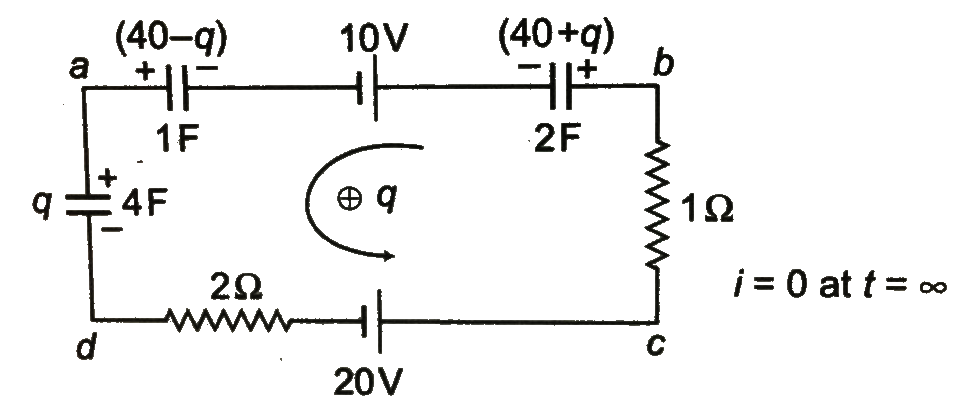How many time constants will elapse before the current in a charging R−C circuit drops to half of its initial value?
To solve the problem of how many time constants will elapse before the current in a charging R-C circuit drops to half of its initial value, we can follow these steps:
1. Understand the Formula for Current in an R-C Circuit:
The current I in a charging R-C circuit is given by the equation:
I=I0e−tRC
where:
- I0 is the initial current,
- R is the resistance,
- C is the capacitance,
- t is the time,
- e is the base of the natural logarithm.
2. Set the Current to Half of Its Initial Value:
We want to find the time t when the current I is half of its initial value I0:
I=I02
3. Substitute into the Current Equation:
Substitute I=I02 into the current equation:
I02=I0e−tRC
4. Cancel I0:
Since I0 is common on both sides of the equation and not equal to zero, we can cancel it:
12=e−tRC
5. Take the Natural Logarithm:
To solve for t, take the natural logarithm of both sides:
ln(12)=−tRC
6. Simplify the Natural Logarithm:
We know that ln(12)=−ln(2):
−ln(2)=−tRC
This simplifies to:
ln(2)=tRC
7. Solve for t:
Rearranging gives:
t=RCln(2)
8. Approximate ln(2):
The value of ln(2) is approximately 0.693:
t≈0.693RC
9. Determine the Number of Time Constants:
Since one time constant τ is defined as τ=RC, we can express the time in terms of time constants:
t≈0.693τ
Final Answer:
The time it takes for the current to drop to half of its initial value is approximately 0.693 time constants.
---
The current I in a charging R-C circuit is given by the equation:
I=I0e−tRC
where:
- I0 is the initial current,
- R is the resistance,
- C is the capacitance,
- t is the time,
- e is the base of the natural logarithm.
We want to find the time t when the current I is half of its initial value I0:
I=I02
Substitute I=I02 into the current equation:
I02=I0e−tRC
Since I0 is common on both sides of the equation and not equal to zero, we can cancel it:
12=e−tRC
To solve for t, take the natural logarithm of both sides:
ln(12)=−tRC
We know that ln(12)=−ln(2):
−ln(2)=−tRC
This simplifies to:
ln(2)=tRC
Rearranging gives:
t=RCln(2)
The value of ln(2) is approximately 0.693:
t≈0.693RC
Since one time constant τ is defined as τ=RC, we can express the time in terms of time constants:
t≈0.693τ
The time it takes for the current to drop to half of its initial value is approximately 0.693 time constants.
Topper's Solved these Questions
- BOOK - DC PANDEY ENGLISHCHAPTER - CAPACITORSEXERCISE - OBJECTIVE_TYPE1videos
CAPACITORS
- BOOK - DC PANDEY ENGLISHCHAPTER - CAPACITORSEXERCISE - OBJECTIVE_TYPE1videos
CAPACITORS
- BOOK - DC PANDEY ENGLISHCHAPTER - ATOMSEXERCISE - MEDICAL ENTRANCES GALLERY42videos
ATOMS
- BOOK - DC PANDEY ENGLISHCHAPTER - COMMUNICATION SYSTEMEXERCISE - Subjective11videos
COMMUNICATION SYSTEM
Similar Questions
In the circuit shown as potential difference of 60V is appliled across AB. The potential difference between the points M and N is
 02:18View Solution
02:18View SolutionIn the circuit shown as potential difference of 60V is appliled across AB. The potential difference between the points M and N is
 View Solution
View SolutionGiven the value of Rydberg constant is 107m−1, the waves number of the last line of the Balmer series in hydrogen spectrum will be:
View SolutionThe LC product of a tuned amplifier circuit require to generate a carrier wave of 1 MHz for amplitude modulation is
09:15View SolutionHow many time constants will elapse before the charge on a capacitor falls to 0.1%of its maximum value in a discharging RC circuit.
03:49View SolutionHow many time constants will elapse before the energy stored in the capacitor reaches half of its equilibrium value in a charging RC circuit ?
04:39View Solutionhow many time constants will elapse before the power delovered by the battery drops to half of its maximum value in an RC circuit ?
View SolutionA coil having an inductance L and a resistance R is connected to a battery of emfε. Find the time elapsed before (a) the current reaches half its maximum value, (b) the power dissipated in heat reaches half its maximum value and © the magnetic field energy stored in the circuit reaches half its maximum value.
02:58View SolutionHow many time constant will elapse before the power delivrered by the battery drops to half of its maximum value.
02:33View SolutionIn charging singe loop R - C circuit, after how many time constant, kthe potential energy in the capacitor will be 25% of its maximum value.
03:05View SolutionIn the question number 93, the time elapsed for its mechanical energy to drop half of its initial value is
03:00View SolutionHow many time constants will elapse before a capacitor gains 99% of its steady state charge?
03:49View SolutionHow many time constants will elapse before the charge on a capacitor falls to 0.1%of its maximum value in a discharging RC circuit.
View SolutionHow many time constants will elapse before the energy stored in the capacitor reaches half of its equilibrium value in a charging RC circuit ?
View Solutionhow many time constants will elapse before the power delovered by the battery drops to half of its maximum value in an RC circuit ?
04:21View SolutionHow many time constants will elapse before the energy stored in the capacitor reaches half of its equilibrium value in a charging RC circuit?
02:45View Solution

